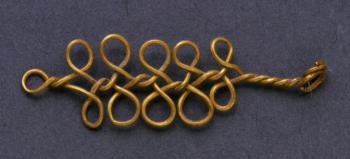American Journal of Archaeology | The Journal of the Archaeological Institute of America
You are here
Symbols of Fertility and Abundance in the Royal Cemetery at Ur, Iraq
January 2013 (117.1)
Symbols of Fertility and Abundance in the Royal Cemetery at Ur, Iraq
Fertility and abundance are important themes of ancient Mesopotamian texts and images. The goddess Inanna and her consort Dumuzi personify these ideas in texts of the second millennium B.C.E. Excavated by Leonard Woolley in the 1920s, the Royal Cemetery at Ur dates to the mid third millennium B.C.E. Among the tombs, that of Queen Puabi yielded many ornaments of gold, carnelian, and lapis. Some of the pendants realistically depict identifiable animals. Others are more stylized depictions of clusters of apples, dates, and date inflorescences. Apples and dates are both associated with the goddess Inanna, who is associated with love and fertility. Twisted wire pendants in the same group of objects are not so readily identified. I propose here that the twisted wire pendants in the Puabi assemblage may literally represent rope, symbolically reference sheep, and narratively evoke the flocks of the shepherd Dumuzi. Pairing symbols of Inanna and Dumuzi evokes life in a place of death. This article considers and rejects the following identifications for the wire pendants: stylized palmette, pinnate leaf, grape (and implicitly any other fruit cluster), water, road, canal, and snake.
Symbols of Fertility and Abundance in the Royal Cemetery at Ur, Iraq
By Naomi F. Miller
American Journal of Archaeology Vol. 117, No. 1 (January 2013), pp. 127–133
DOI: 10.3764/aja.117.1.0127
© 2013 Archaeological Institute of America



Comments
How about "entanglement to
How about "entanglement to infinity". These ear pendants might be used to assure "the god´s whispering honoring moon deities for the 11 wholes". I have been in UR in 1980. And at Eridur
As a point of information:
As a point of information: these are not 'ear pendants'; they are more likely to have been attached to beaded necklaces.
Number of loops: Only one
Number of loops: Only one twisted pendant was illustrated. As the article clearly states: "Nine have nine loops and three have eleven loops arranged along a vertical axis. One has four pairs of loops and one has six pairs."
One more thing, the small
One more thing, the small knot at the right far end might represent "sealed accomplishment". No one can untie it. Not even "the gods"... not even Enki.
The bit at the right is not a
The bit at the right is not a knot. Rather, it is the loop from which the pendant hung. As it is not a knot, and is not sealed (just twisted), it seems unlikely to represent a 'sealed accomplishment'. Sadly, the only place to see this material on display is in the Penn Museum, Philadelphia. The photographs clearly do not do these items justice.
Could these represent
Could these represent clusters of grapes?
As I mention on page 130:
As I mention on page 130: "Perhaps the loops represent grapes. Here, too, one must consider how other fruit forms are made. Both dates and apples “in their clusters” are quite three- dimensional and are not depicted in outline. Unlike dates, grapes and grapevines do not appear in the im- agery of mid third-millennium Mesopotamia."
The short answer: No.
I have to say a cluster of
I have to say a cluster of grapes was my thought too. Still a fertility symbol though, as explained in Dr. Miller's introduction above.
Similar adornments are made
Similar adornments are made in various parts of africa for use on pendants or earrings. There are no associated symbolic meanings. (I live in Burundi, central africa, and have worked and travelled widely in africa and the middle east ...)
://dianabuja.wordpress.com
Add new comment